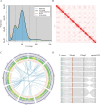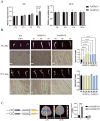Haplotype-resolved genome of Prunus zhengheensis provides insight into its evolution and low temperature adaptation in apricot
- PMID: 38689698
- PMCID: PMC11059810
- DOI: 10.1093/hr/uhae103
Haplotype-resolved genome of Prunus zhengheensis provides insight into its evolution and low temperature adaptation in apricot
Abstract
Prunus zhengheensis, an extremely rare population of apricots, originated in warm South-East China and is an excellent material for genetic breeding. However, most apricots and two related species (P. sibirica, P. mandshurica) are found in the cold northern regions in China and the mechanism of their distribution is still unclear. In addition, the classification status of P. zhengheensis is controversial. Thus, we generated a high-quality haplotype-resolved genome for P. zhengheensis, exploring key genetic variations in its adaptation and the causes of phylogenetic incongruence. We found extensive phylogenetic discordances between the nuclear and organelle phylogenies of P. zhengheensis, which could be explained by incomplete lineage sorting. A 242.22-Mb pan-genome of the Armeniaca section was developed with 13 chromosomal genomes. Importantly, we identified a 566-bp insertion in the promoter of the HSFA1d gene in apricot and showed that the activity of the HSFA1d promoter increased under low temperatures. In addition, HSFA1d overexpression in Arabidopsis thaliana indicated that HSFA1d positively regulated plant growth under chilling. Therefore, we hypothesized that the insertion in the promoter of HSFA1d in apricot improved its low-temperature adaptation, allowing it to thrive in relatively cold locations. The findings help explain the weather adaptability of Armeniaca plants.
© The Author(s) 2024. Published by Oxford University Press on behalf of Nanjing Agricultural University.
Conflict of interest statement
The authors declare no conflict of interest.
Figures






Similar articles
-
The chloroplast genome of Prunus zhengheensis: Genome comparative and phylogenetic relationships analysis.Gene. 2021 Aug 15;793:145751. doi: 10.1016/j.gene.2021.145751. Epub 2021 May 29. Gene. 2021. PMID: 34062257
-
Genomic evidence for evolutionary history and local adaptation of two endemic apricots: Prunus hongpingensis and P. zhengheensis.Hortic Res. 2023 Oct 27;11(4):uhad215. doi: 10.1093/hr/uhad215. eCollection 2024 Apr. Hortic Res. 2023. PMID: 38689695 Free PMC article.
-
Genome-wide and functional analysis of late embryogenesis abundant (LEA) genes during dormancy and sprouting periods of kernel consumption apricots (P. armeniaca L. × P. sibirica L.).Int J Biol Macromol. 2024 Nov;279(Pt 3):133245. doi: 10.1016/j.ijbiomac.2024.133245. Epub 2024 Jul 6. Int J Biol Macromol. 2024. PMID: 38977045
-
Sequencing and Phylogenetic Analysis of the Chloroplast Genome of Three Apricot Species.Genes (Basel). 2023 Oct 18;14(10):1959. doi: 10.3390/genes14101959. Genes (Basel). 2023. PMID: 37895308 Free PMC article.
-
Anticancer Potential and Other Pharmacological Properties of Prunus armeniaca L.: An Updated Overview.Plants (Basel). 2022 Jul 20;11(14):1885. doi: 10.3390/plants11141885. Plants (Basel). 2022. PMID: 35890519 Free PMC article. Review.
Cited by
-
Construction of the super pan-genome for the genus Actinidia reveals structural variations linked to phenotypic diversity.Hortic Res. 2025 Mar 3;12(6):uhaf067. doi: 10.1093/hr/uhaf067. eCollection 2025 Jun. Hortic Res. 2025. PMID: 40303430 Free PMC article.
-
Integrating multiomics and modern breeding tools for accelerating genetic improvement in Annonas.Funct Integr Genomics. 2025 Jul 12;25(1):155. doi: 10.1007/s10142-025-01653-7. Funct Integr Genomics. 2025. PMID: 40646364 Free PMC article. Review.
References
-
- Zhang QP, Liu W. Advances of the apricot resources collection, evaluation and germplasm enhancement. Acta Hortic Sin. 2018;45:1642–60
-
- Zhang J, Zhang Z. China Fruit-Plant Monographs, Apricot Flora. Beijing: China Forestry Press; 2003:
-
- Yu D. Flora of China, Armeniaca, Rosaceae. In Chinese Academy of Sciences Editorial Boardeds Chinese Academy of Sciences Editorial Board, eds. Beijing: Science Press; 1986:27–30
-
- Zhang J, Lv M, Wang Z. Two new species of the genus Armeniaca (Rosaceae). Acta Phytotaxon Sin. 1999;37:106–10
LinkOut - more resources
Full Text Sources
Miscellaneous

